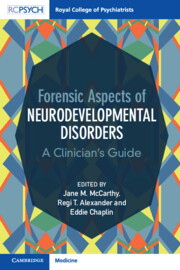Book contents
- Forensic Aspects of Neurodevelopmental Disorders
- Forensic Aspects of Neurodevelopmental Disorders
- Copyright page
- About the Cover Page
- Contents
- Contributors
- Foreword by the Rt Hon Lord Bradley
- Terminology Used in the Book
- Section 1 An Overview: Definitions, Epidemiology and Policy Issues
- Section 2 Assessment and Therapeutic Approach
- Section 3 Criminal Justice Pathways and Legal Issues
- Chapter 16 Criminal Justice Pathways and Neurodevelopmental Disorders
- Chapter 17 The Mental Health Act and Other Relevant Legislation in Relation to Neurodevelopmental Disorders in the UK
- Chapter 18 Fitness to Plead and Neurodevelopmental Disorders
- Chapter 19 Fitness to Plead Procedures in Relation to Mental Health and Capacity Legislation
- Chapter 20 Forensic Services for Neurodevelopmental Disorders: An English Perspective
- Chapter 21 Offenders with Neurodevelopmental Disorders in Four Nordic Countries
- Chapter 22 Forensic Neurodevelopmental Disabilities: A Perspective from Ontario, Canada on Pathways and Services
- Chapter 23 Forensic Aspects of Neurodevelopmental Disorders: An Australasian Perspective
- Chapter 24 Concluding Comments
- Index
- References
Chapter 16 - Criminal Justice Pathways and Neurodevelopmental Disorders
from Section 3 - Criminal Justice Pathways and Legal Issues
Published online by Cambridge University Press: 18 May 2023
- Forensic Aspects of Neurodevelopmental Disorders
- Forensic Aspects of Neurodevelopmental Disorders
- Copyright page
- About the Cover Page
- Contents
- Contributors
- Foreword by the Rt Hon Lord Bradley
- Terminology Used in the Book
- Section 1 An Overview: Definitions, Epidemiology and Policy Issues
- Section 2 Assessment and Therapeutic Approach
- Section 3 Criminal Justice Pathways and Legal Issues
- Chapter 16 Criminal Justice Pathways and Neurodevelopmental Disorders
- Chapter 17 The Mental Health Act and Other Relevant Legislation in Relation to Neurodevelopmental Disorders in the UK
- Chapter 18 Fitness to Plead and Neurodevelopmental Disorders
- Chapter 19 Fitness to Plead Procedures in Relation to Mental Health and Capacity Legislation
- Chapter 20 Forensic Services for Neurodevelopmental Disorders: An English Perspective
- Chapter 21 Offenders with Neurodevelopmental Disorders in Four Nordic Countries
- Chapter 22 Forensic Neurodevelopmental Disabilities: A Perspective from Ontario, Canada on Pathways and Services
- Chapter 23 Forensic Aspects of Neurodevelopmental Disorders: An Australasian Perspective
- Chapter 24 Concluding Comments
- Index
- References
Summary
People with a wide range of mental health and neurodevelopmental conditions are found amongst criminal justice populations, and many present with co-occurring disorders. These may include other neurodevelopmental conditions, substance use disorders or physical health conditions. It is now standard practice to use a pathways approach to organise and deliver services, and journeys taken by many people within criminal justice systems lend themselves to this, at least in theory. Basic requirements of this approach include police custody and prison reception screening, providing organised multidisciplinary care and introducing appropriate interventions as part of individual care plans. There is much we still do not know about vulnerable people in prisons, and service provision remains far from optimal. In particular, insufficient specialist provision means that many people with neurodevelopmental conditions are not identified appropriately, and do not have their needs met as they should. Further, in the absence of support, the presentations of some people render them vulnerable to specific aspects of prison life.
Keywords
- Type
- Chapter
- Information
- Forensic Aspects of Neurodevelopmental DisordersA Clinician's Guide, pp. 191 - 201Publisher: Cambridge University PressPrint publication year: 2023
References
- 1
- Cited by



